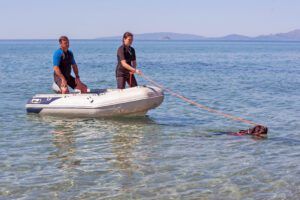It’s a common myth that all dogs can swim.
Not all dogs have the coordination or the physique to swim. Some don’t even like to get wet. But other dogs–especially Labradors, Golden Retrievers, and Newfies–love the water and paddling around in it.
Most Chihuahuas, though, do not like water–because they have no fur and get cold– and they can’t swim– because their pads are so small. Plus, their tiny stature means they can be swept away by waves or currents. But there are exceptions in this feisty breed, individuals who love to swim once they learn.
Yes, that means that – although your dog might never be the canine Michael Phelps – you can teach most dogs to swim. How? Start slowly, stay calm and confident, and let the dog tell you what he wants to do.
- Buy him a well-fitting life jacket, especially if you’re not a strong swimmer yourself.
- If you’re going to teach him in your pool, build him a ramp to get in and out. It’s safer for him and for people already in the pool if he doesn’t just leap in. (And be absolutely certain he cannot access the pool if you’re not watching him.) If you don’t have a pool, find a lake or a slow stream with a sandy bottom and ankle-deep water to calmly introduce him to water and to moving through it.
- Introduce him to swimming by either supporting his body by placing your forearms under his belly or by holding on to the handle at the top of the life jacket. Dogs will usually figure out how to swim by moving their legs in diagonal pairs if your support keeps them from fighting just to keep their heads above water. You can also touch their hind pads to make them move their hind legs.
- Have fun in the water! Just make sure your dog doesn’t get overtired and unable to stay afloat.
Can French Bulldogs Swim?
For other dogs, like French Bulldogs, physiology and conformation has a lot to do with being unable to swim well. Dogs with heavy bones, wide chests, and short hair – Dobermans, Rottweilers, Bulldogs – generally don’t float well, so they tend to paddle with only their front legs and not go forward through the water. Thus, they sink, hind end first, which only adds to their panic.
Dogs with thick or long coats and lighter builds – Labs and Golden Retrievers – float more easily and stay warm in cold water. And the Newfoundland has giant, webbed paws that propel him purposely through the water, helping to make the breed outstanding at water rescue.
How Most Dogs Swim
According to a 2014 article published by the Society for Integrative and Comparative Biology and by Science Daily, Dr. Frank Fish of West Chester University (Pa.) did a study of how different dog breeds swim. He used eight dogs of different breeds, from a Yorkshire Terrier to a Newfoundland, and he videotaped their nearly uniform motion in a pool.
His film showed that dogs don’t do the doggie paddle! The motion is diagonal pairs–like trotting, except faster and with much greater range of motion, which is why swimming is great exercise for them.
Dr. Fish’s research also led him to believe that water mammals – whales, walruses, and sea otters–were originally land animals with long legs and large feet that were better suited to swimming. These then, over generations, became fins.







That would be a Hard NO! My rough collies sink like rocks. Heck, they don’t even try. This is why the pool has an extra fence around it.
All my dogs (except one) swim with me daily and enjoy the experience. However, the first thing I teach is how to get out of the pool on their own. This comes before anything else.